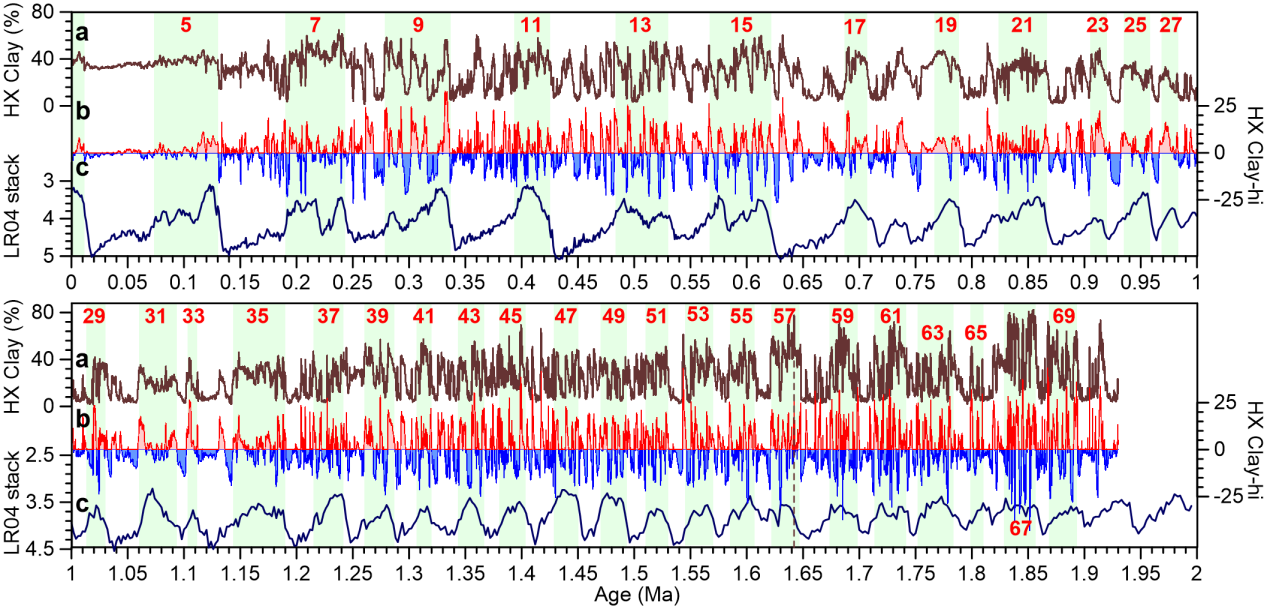2025-06-06 中国科学院(CAS)
 Abrupt climate changes over the last 2 Ma. (a) Clay content of HX core; (b) Strong (red) and weak (blue) monsoon events inferred from high-frequency component of HX clay content; (c) Benthic δ18O stack. (Image by SUN, et al)
Abrupt climate changes over the last 2 Ma. (a) Clay content of HX core; (b) Strong (red) and weak (blue) monsoon events inferred from high-frequency component of HX clay content; (c) Benthic δ18O stack. (Image by SUN, et al)
<関連情報>
- https://english.cas.cn/newsroom/research_news/earth/202506/t20250606_1045163.shtml
- https://www.pnas.org/doi/10.1073/pnas.2426353122
更新世間氷期における軌道下および千年規模のモンスーン変動 Suborbital- and millennial-scale monsoon variability during Pleistocene interglacials
Youbin Sun, Ting Wang, Qiuzhen Yin, +11 , and Zhisheng An
Proceedings of the National Academy of Sciences Published:June 2, 2025
DOI:https://doi.org/10.1073/pnas.2426353122
Significance
Marine and ice-core records demonstrate that Heinrich events and DO cycles were persistently significant during the Pleistocene glaciations. However, it remains unclear how abrupt climate events evolved during past warm periods and whether the driving mechanisms differ between glacial and interglacial boundary conditions. Our centennial-resolution grain size proxies from a 512-m lacustrine-dominated core reveal that monsoon-induced lake level in the Weihe Basin fluctuated dramatically on suborbital and millennial timescales during Pleistocene interglacials. We propose that rapid monsoon changes during Pleistocene interglacials could be triggered by bihemispheric maximum insolation over the low-latitude oceans. Our unique record provides a natural analog for predicting the future trajectory of periodic extreme climate events.
Abstract
Observational and modeling results show that the frequency and amplitude of extreme climatic events have increased significantly in the context of global warming. However, whether abrupt climate changes intensified during past warm periods remains poorly constrained due to the lack of high-resolution geological records. Here, we report a 512-m predominantly lacustrine sedimentary record from the Weihe Basin (North China), revealing that lake levels fluctuated significantly on suborbital (half- and quarter-precession) and millennial timescales over the last 2 Ma. Grain-size results reveal that magnitudes of rapid lake level fluctuations increased dramatically during Pleistocene interglacials, differing from glacial amplification of abrupt climate events recorded in North Atlantic marine sediments. Model results indicate that summer insolation maxima in low-latitude region of both hemispheres can lead to intensified monsoon precipitation in East Asia. Our proxy-model comparison highlights the importance of low-latitude bihemispheric insolation maxima in driving millennial-scale hydroclimatic variability in a warming future.



